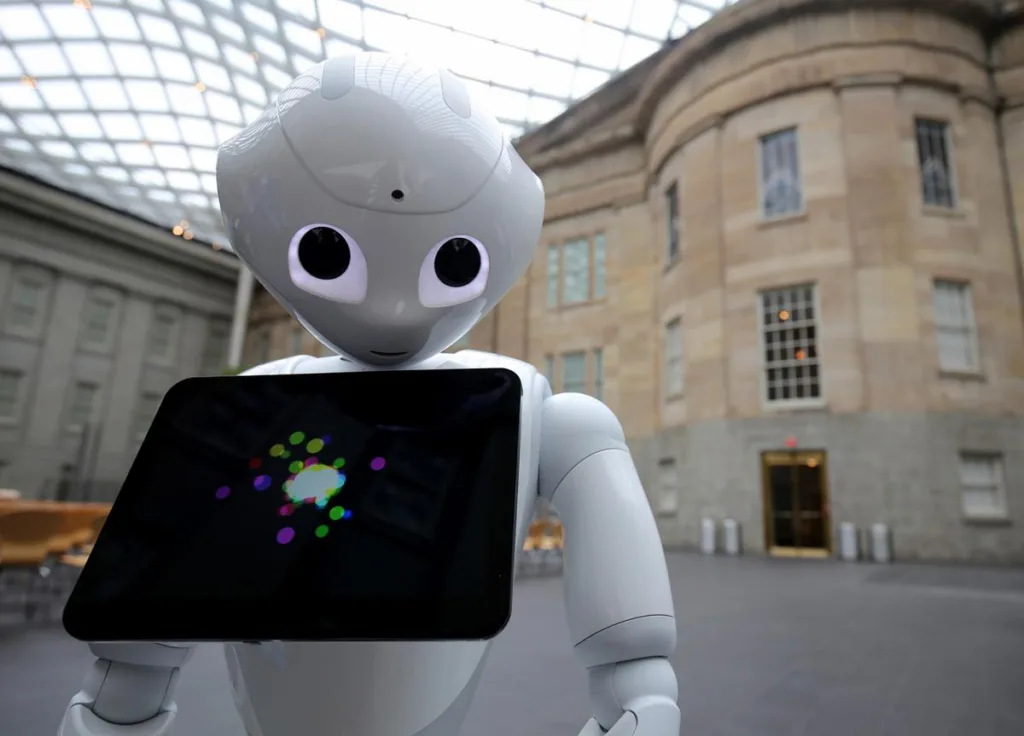Museum Transformations: AI as a new digital tool to enhance Museums
AI enriches museums with virtual tours, interactive exhibits and robotic assistants. The debate continues on the loss of human contact and balance between entertainment and education. How digital tools become crucial.
29 November 2023
When it comes to museums, AI can be incorporated in a variety of ways, from the visitor experience to behind the scenes.
It is used to improve visitors’ experience and access to the museum through websites, chatbots, and analytics tools. They make systems more efficient and can save museums time and money.
Another example is AI-generated content. AI is used to analyze and interpret data and information, which is then used to create or generate content such as text, images and video.
This content is then used within virtual tours and exhibitions in which visitors come into contact with generative art.
For example, the Louvre Museum in Paris has partnered with a technology company to create a virtual tour using artificial intelligence-generated content(link to tool). The virtual tour includes 360-degree views of the museum’s most famous exhibits, as well as audio and video guides that provide historical and cultural context.
Using AI algorithms, virtual exhibitions can create unique and different works of art each time they are viewed.
This content can be used by cultural institutions to create interactive exhibits that respond to visitors’ movements or preferences, or to provide virtual tours of historic sites that are no longer accessible to the public.
Finally, it can also be used to create virtual exhibitions that are accessible to everyone, including people who cannot travel in person due to mobility or other problems.
Some examples of the use of AI in cultural institutions are:
In 2015, French company Aldebaran Robotics, developed a humanoid robot called Pepper(link to news story) These robots occupy three Smithsonian museums in Washington with the purpose of answering visitors’ questions and telling stories using voice, gestures and an interactive touch screen.

The Louvre Abu Dhabi has used artificial intelligence to create an interactive exhibit called “Artificial Intelligence and Intuition”(link to news story). The exhibition uses artificial intelligence to analyze visitors’ movements and emotions and responds with a personalized audio and visual experience.
Museums use artificial intelligence to analyze historical data and predict visitor behavior in a variety of ways. This data can be used to better allocate resources and plan future events. One of the cases is the Art Institute of Chicago, which in 2015 and 2016 used a sophisticated attendance model to test the effect of smaller exhibitions on attendance(link to news story). The institute has been able to measure the success and popularity of some exhibitions and develop strategies to increase museum attendance.
Museums also use artificial intelligence to engage audiences. One example is the case of Google’s Arts&Culture App, which launched the Art Selfie update(link to tool). Users of the app were asked to take a selfie, and with the help of facial recognition, the app was able to search through thousands of artworks for the most similar subject.Google Arts & Culture has partnered with famous museums around the world, brought greater global exposure to museums.
The impact of AI on museums is a topic of ongoing debate and discussion. As we have seen, use offers a number of advantages, such as prioritizing entertainment and spectacle over education and learning, but there are concerns about the impact on the unique qualities of the traditional museum experience. Indeed, some believe that the use of AI could lead to a loss of human connection, a fundamental part of the traditional museum and gallery experience.
The integration of Artificial Intelligence into museums offers undeniable benefits, improving access, efficiency and creativity in cultural experiences. It is important to strike a balance between technological innovation and the preservation of human interaction with art and history. The debate on the impact of AI in museums needs to be addressed carefully, looking for solutions that enrich rather than replace the human experience.
In this way, museums can continue to evolve, attracting new audiences without compromising the authenticity and connection that only culture and art can offer.
